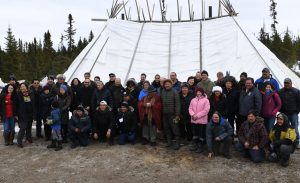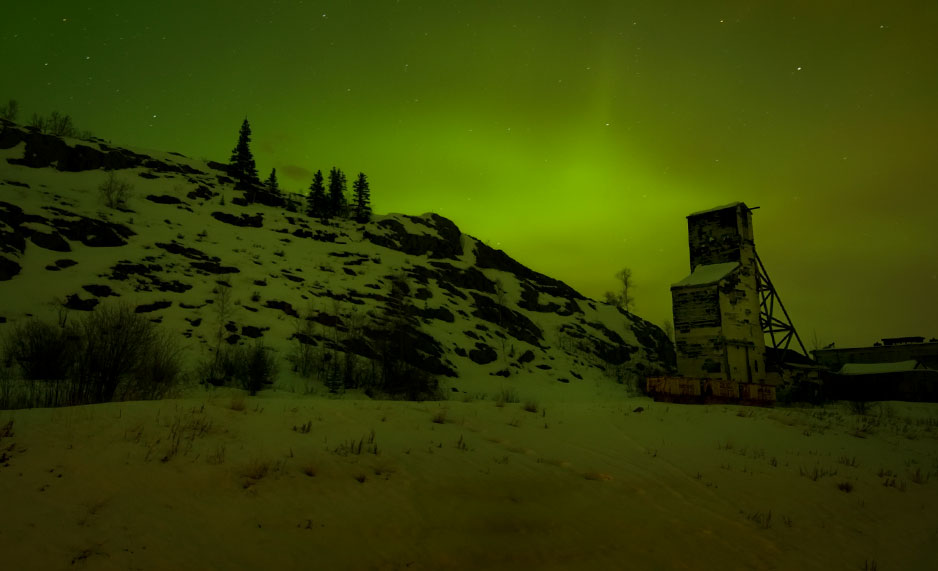Poison and profit: mining on traditional lands
In the underground depths of northern Canada lies a monster. That’s how Mary Rose Sundberg of the Goyatiko Language Society describes the 237,000 tons of arsenic left underground from an abandoned mining project. Giant Mine has poisoned surrounding waters, contaminated 328,000 cubic metres of soil, and caused the death of at least one child.
The plan is for the remaining arsenic to remain frozen underground forever, yet ‘forever’ is a concept that transcends budgets and technology. It’s a time frame of myths, hence why it’s fitting to describe the arsenic as a monster.
Giant Mine is one of around 10,000 abandoned mining projects across Canada. While not all have the same poisonous past, many face a common challenge: how should abandoned extraction projects be managed?
In watching Guardians of Eternity – one of the two films presented by REXSAC last month at the Nordic Museum – it became clear that there is no satisfying answer. In the case of Giant Mine, companies that controlled the site from 1948 to 2004 made $1.1 billion in profits. But it was the Canadian government that assumed responsibility for cleaning up the site, and $903 million of taxpayers’ money was put towards short-term clean-up costs alone.
While the clean-up bill is significant enough, the damage is more than financial. The nearby Yellowknives Dene First Nations people – who were not properly consulted when the mine was first constructed – have already suffered from the contaminated lands, continue to grieve, and are painfully aware of the continued risk.
A positive path for future projects
Giant Mine was established in the 1940s when the regulatory regime was almost non-existent. Regulations have since come a long way, but uncertainties remain. Sweden is thought to have some of the best environmental laws in the world, but its mining companies can still go bankrupt and leave the clean-up bill to the government and taxpayers, as with Blaiken mine in Västerbotten county.
Good regulation is vital, and environmental assessments are an important part of that process. Making accurate assessments is not always easy and the past has shown us that mistakes can be made – so this process must continue to build on the best available evidence and be subject to rigorous review. It is a generally accepted norm across the world that assessments should be conducted in partnership with indigenous communities, both out of respect for their rights and to ensure the assessments are of adequate quality.

The second film presented by REXSAC looked at the negotiation and assessment processes in Canada and Sweden. Chief Abel Bosum, negotiator for the Grand Council of the Crees in Canada, explained that developers must obtain consent from the affected community, and revenue-sharing models can be one mechanism to reach an agreement. Khuyagaa Duurenbaat, herder from the Nuudelch Malchid people in Mongolia, mentioned that mining can generate positive outcomes such as job opportunities. However, those financial benefits must be weighed against the environmental and social risks.
It’s important for companies to understand that we are open to dialogue and a constructive process. (Translated)
—Valéria Paye, Kaxuyana people, Coordination of the Indigenous Organizations of the Brazilian Amazon (COIAB)
Identity and rights
Finding a positive direction is vitally important, but these lands are not open for mining companies’ experimentation – local and indigenous communities can’t easily move away after damage has been caused. For the Sami people in Sweden, their future is tied to the land. For those who hunt and fish, doing those activities in their land is part of their identity.
As described by Arn Keeling, a researcher in the REXSAC project who co-led the film viewing with Niila Inga and SEI’s Rasmus Kløcker Larsen, projects like Giant Mine are ‘colonialism written into the landscape’. Some mining companies flout environmental and social norms, take what they can and then leave – leading to repeated cases of injustice, displacement, and dispossession.

The Yellowknives Dene First Nations people whose lands were poisoned by Giant Mine are moving forward. They conduct rituals of healing; they are working with scientists to monitor the safety of the water and the land; and they are working to find ways to preserve knowledge of the underground dangers of the mine throughout generations. The burden is not their fault, but it’s their legacy.
Indigenous peoples are traditional users of their lands and often have long-term perspectives on sustainable resource use. These two films were powerful reminders of the potentially eternal dangers of resource extraction. Research in REXSAC is seeking to support efforts to avoid such injustices; to ensure long-term environmental safety; to avoid public costs for private gain; and to respect the land’s eternal guardians.
Watch the films
The two films presented by REXSAC at the Nordic Museum are available to watch online.
- Guardians of Eternity (in English, 45 minutes)
- Can environmental assessments protect Sami rights? (in Swedish, 9 minutes)





